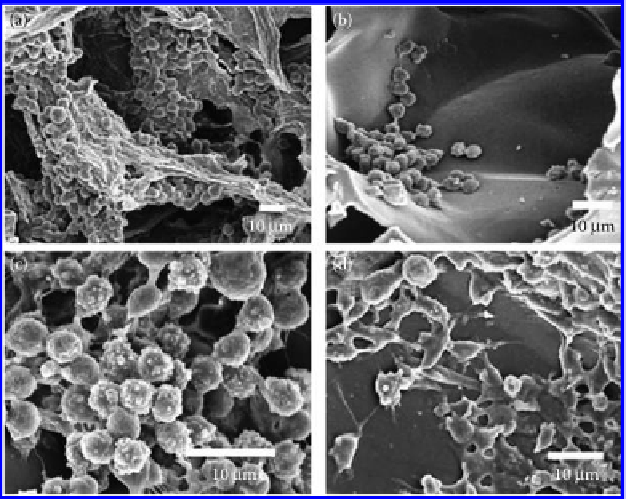Biomedical Engineering Reference
In-Depth Information
Figure 9.29
SEM images of chondrocyte cells grown on (a) chitosan-alginate and (b) chitosan scaffolds after 14 days cell
culture, and on (c) chitosan-alginate and (d) chitosan scaffolds after 21 days of cell culture. (From Li, Z. S. and
Zhang, M. Q. 2005.
J Biomed Mater Res
75A: 485-493. With permission.)
9.5.3.2.4 Chitosan-Synthetic Polymers Scaffold
Synthetic polymers, such as polyethylene oxide (PEO), polyester, poly(dl-lactide), and so on,
are also used to construct artificial skin with chitosan. These polymers can modulate the
structure, degradation behaviors, and mechanical properties of the chitosan scaffold.
Moreover, it can help seeded chondrocytes spread through the scaffolds and distribute
homogeneously inside, can preserve the phenotype of chondrocytes, and effectively sup-
port the production of type II collagen. For example, chitosan-PEO scaffolds were employed
for the cultivation of chondrocytes for the generation of cartilage tissue. The incorporation
of PEO could amend porosity, mechanical brittleness, and ameliorate the biological compat-
ibility of a chitosan scaffold. Porosity and moisture content increased as the weight percent-
age of PEO in chitosan-PEO scaffolds increased. The porosity can achieve the requirement
for cartilage tissue engineering when the weight percentage of PEO is higher than 25%.
PEO was a linear elastomeric polymer; thus an increase in the weight percentage of PEO
reduced Young's modulus and improved the extensibility of the scaffolds. PEO with ether
oxygen is highly hydrophilic. PEO could absorb a large amount of water. Thus an increase
in the weight percentage of PEO promoted the percentage of biodegradation. The chondro-
cyte behaviors on the chitosan-PEO scaffold depended on the composites of the scaffold. In
the chitosan-chitin-PEO scaffold, the range of the composition for a better culture of BKCs
was 25% < PEO < 40%, 12.5% < chitin < 37.5%, and 30% < chitosan < 50% [26,151,152].
9.5.3.2.5 Chitosan Scaffolds Conjugated with Growth Factors
Many studies have suggested that a porous scaffold in itself is insufficient to induce rapid
cartilage regeneration at the initial stages of cartilage healing. Growth factors, affecting the
unique development of cartilage, are crucial for chondrogenesis. For example, TGF-β1 is

Search WWH ::

Custom Search